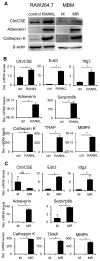Cystathionine γ-lyase accelerates osteoclast differentiation: identification of a novel regulator of osteoclastogenesis by proteomic analysis
- PMID: 24357058
- PMCID: PMC3959796
- DOI: 10.1161/ATVBAHA.113.302576
Cystathionine γ-lyase accelerates osteoclast differentiation: identification of a novel regulator of osteoclastogenesis by proteomic analysis
Abstract
Objective: Clinical evidence has linked vascular calcification in advanced atherosclerotic plaques with overt cardiovascular disease and mortality. Bone resorbing monocyte-derived osteoclast-like cells are sparse in these plaques, indicating that their differentiation capability could be suppressed. Here, we seek to characterize the process of osteoclastogenesis by identifying novel regulators and pathways, with the aim of exploring possible strategies to reduce calcification.
Approach and results: We used a quantitative mass spectrometry strategy, tandem mass tagging, to quantify changes in the proteome of osteoclast-like cells differentiated from RAW264.7 cells in response to, receptor activator of nuclear factor κ-B ligand induction, a common in vitro model for osteogenesis. More than 4000 proteins were quantified, of which 138 were identified as novel osteoclast-related proteins. We selected 5 proteins for subsequent analysis (cystathionine γ-lyase [Cth/CSE], EGF-like repeat and discoidin I-like domain-containing protein 3, integrin α FG-GAP repeat containing 3, adseverin, and serpinb6b) and show that gene expression levels are also increased. Further analysis of the CSE transcript profile reveals an early onset of an mRNA increase. Silencing of CSE by siRNA and dl-propargylglycine, a CSE inhibitor, attenuated receptor activator of nuclear factor κ-B ligand-induced tartrate-resistant acid phosphatase type 5 activity and pit formation, suggesting that CSE is a potent inducer of calcium resorption. Moreover, knockdown of CSE suppressed expression of osteoclast differentiation markers.
Conclusions: Our large-scale proteomics study identified novel candidate regulators or markers for osteoclastogenesis and demonstrated that CSE may act in early stages of osteoclastogenesis.
Keywords: RANKL protein; macrophages; osteoclast; proteomics; vascular calcification.
Figures






Comment in
-
Hydrogen sulfide: a new regulator of osteoclastogenesis?Arterioscler Thromb Vasc Biol. 2014 Mar;34(3):471-3. doi: 10.1161/ATVBAHA.114.303072. Arterioscler Thromb Vasc Biol. 2014. PMID: 24554603 No abstract available.
References
-
- Towler DA. Vascular calcification: a perspective on an imminent disease epidemic. IBMS BoneKEy. 2008;5:41–58.
-
- Huang H, Virmani R, Younis H, Burke AP, Kamm RD, Lee RT. The impact of calcification on the biomechanical stability of atherosclerotic plaques. Circulation. 2001;103:1051–1056. - PubMed
Publication types
MeSH terms
Substances
Grants and funding
LinkOut - more resources
Full Text Sources
Other Literature Sources
Molecular Biology Databases
Miscellaneous

